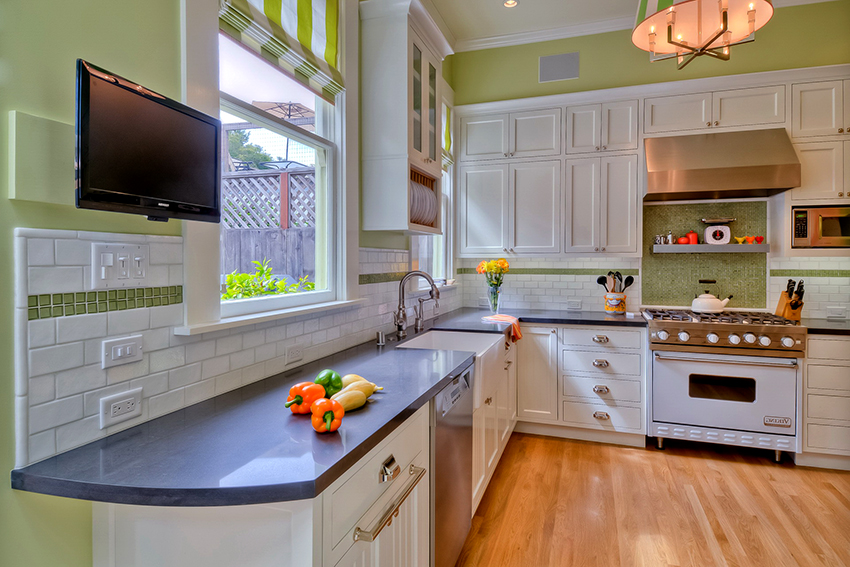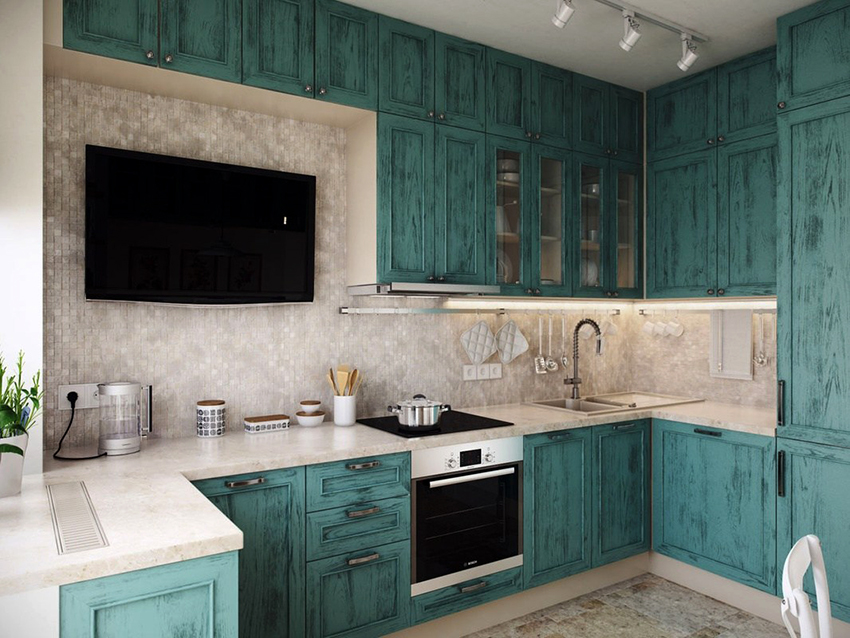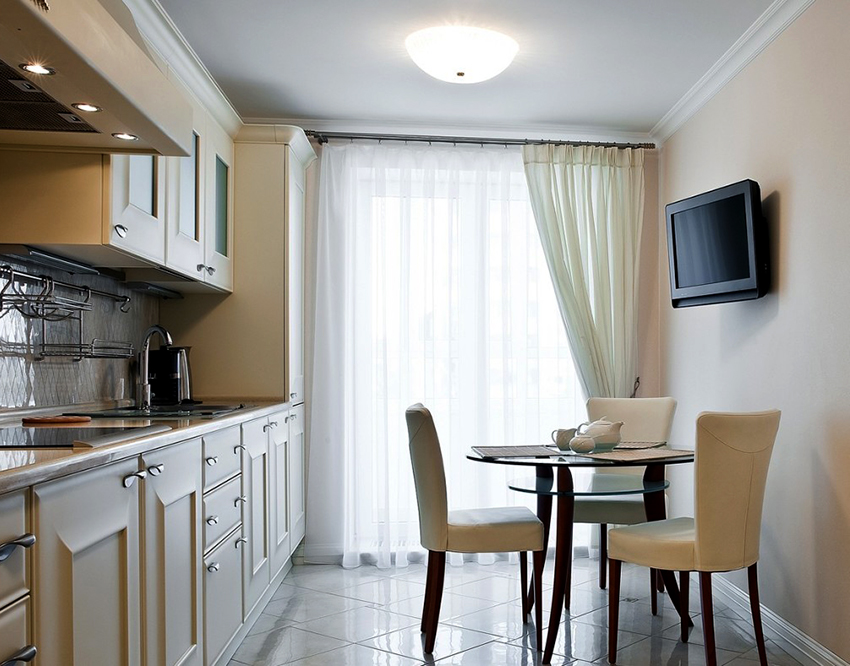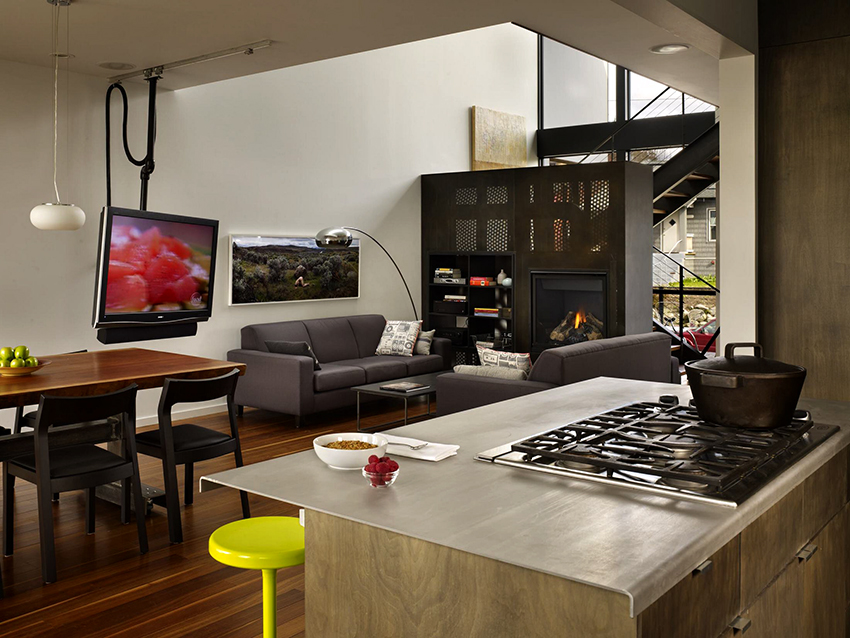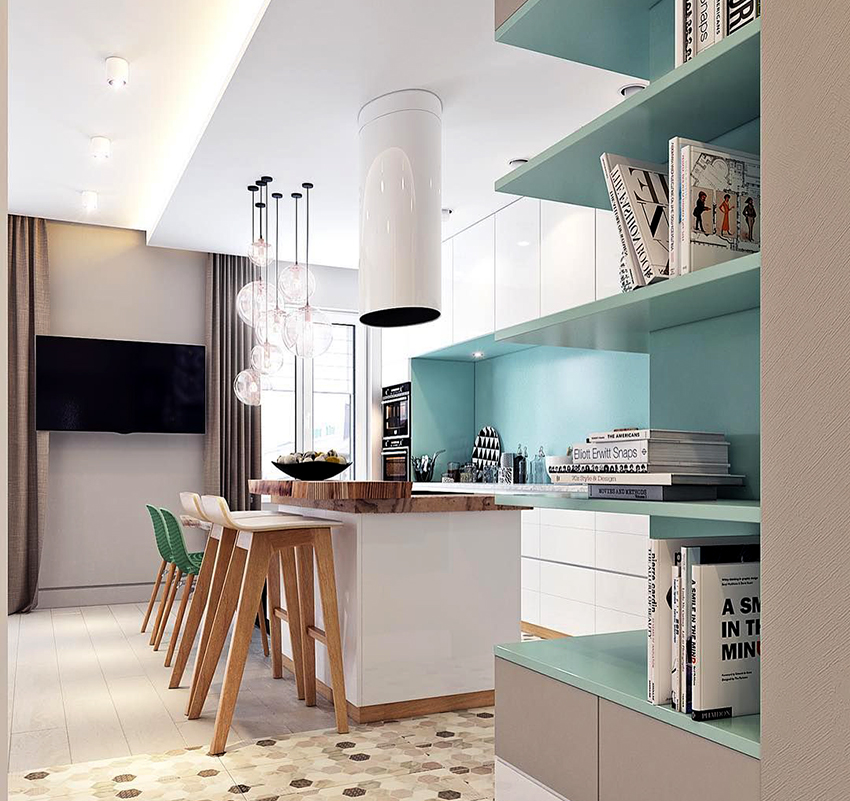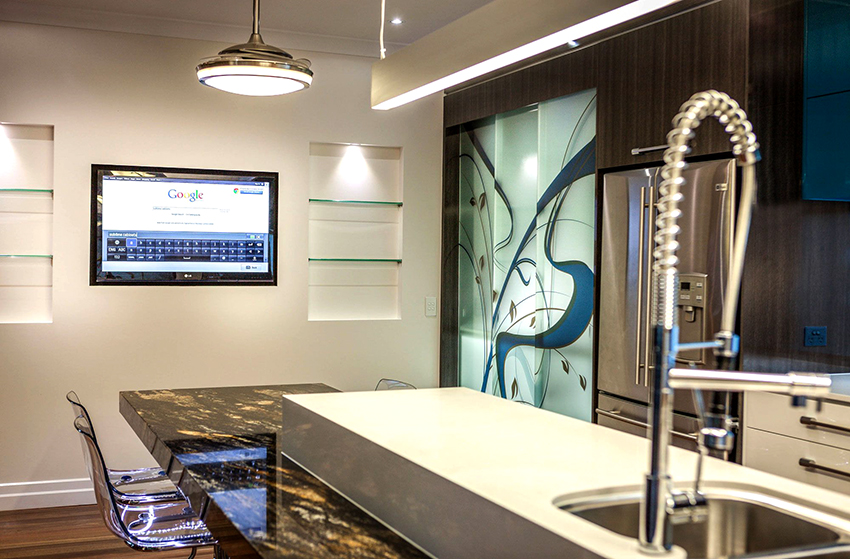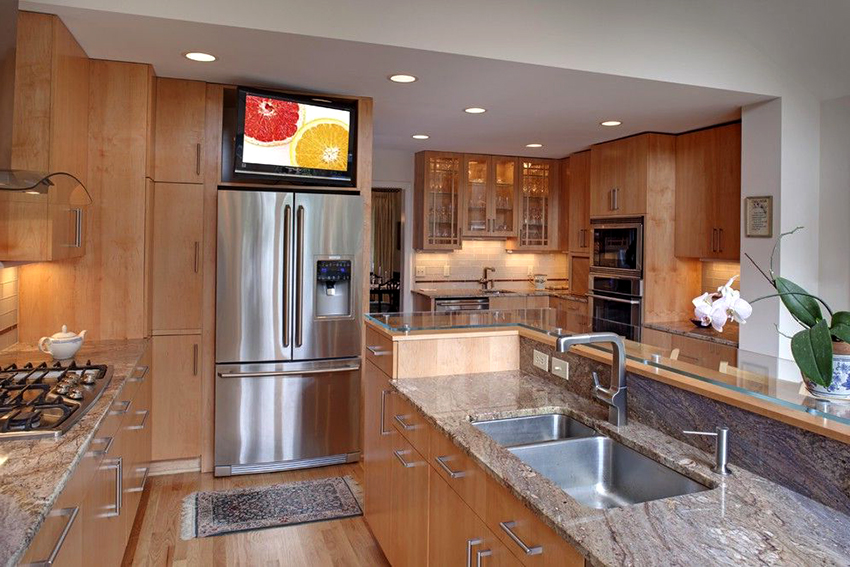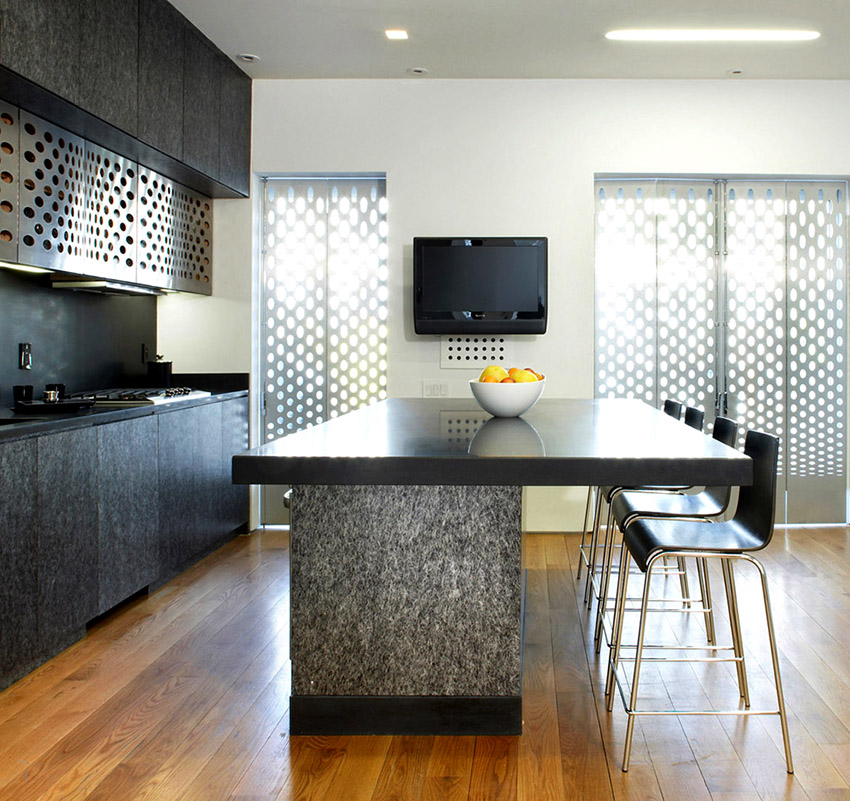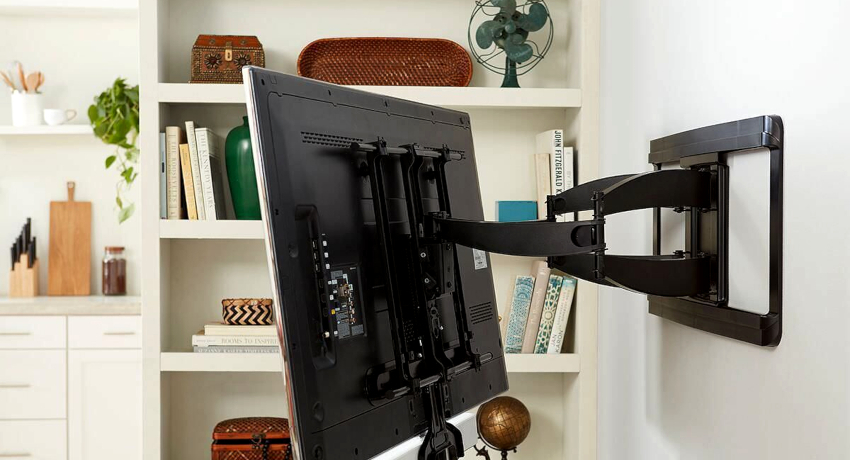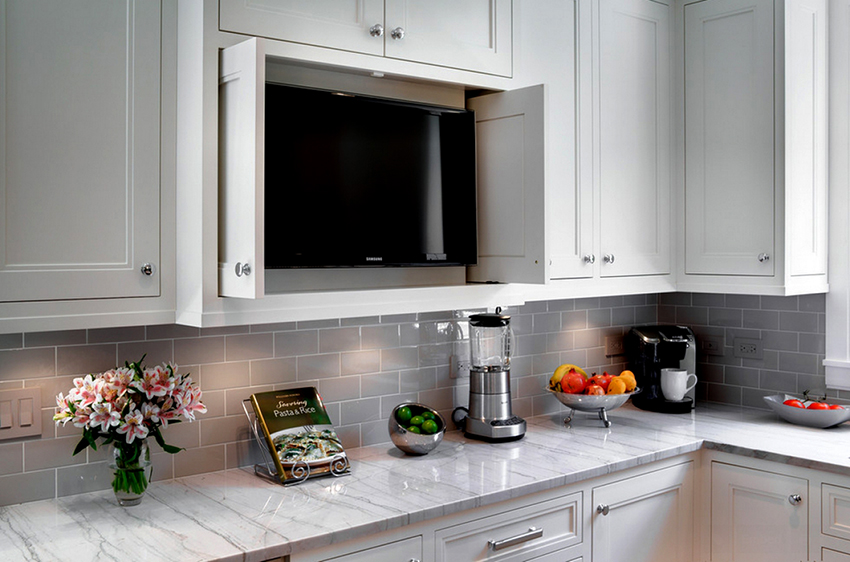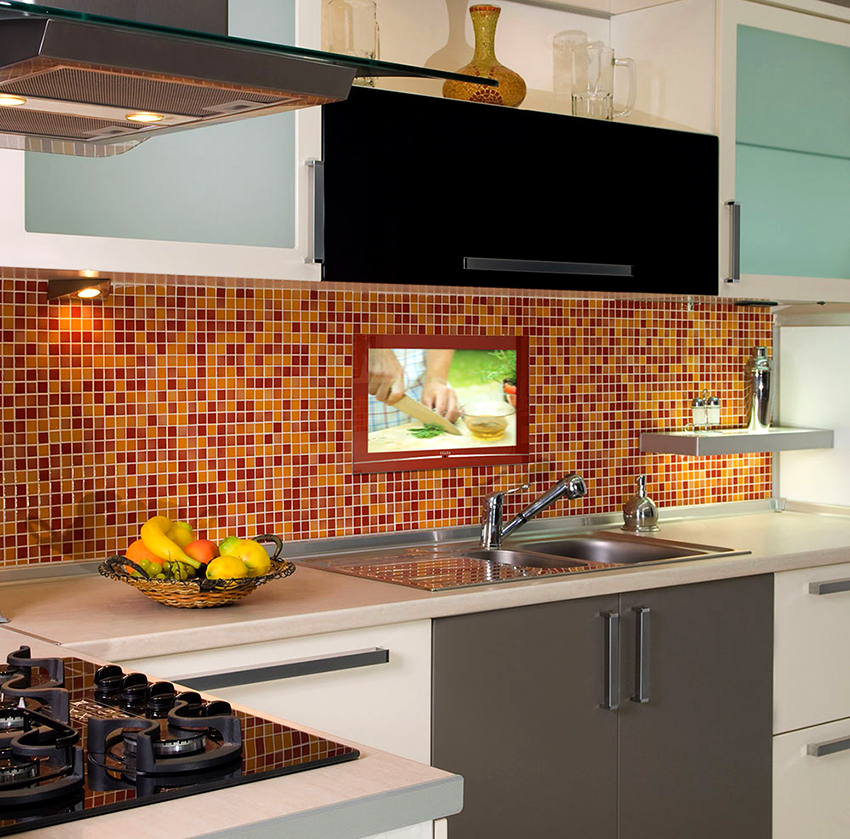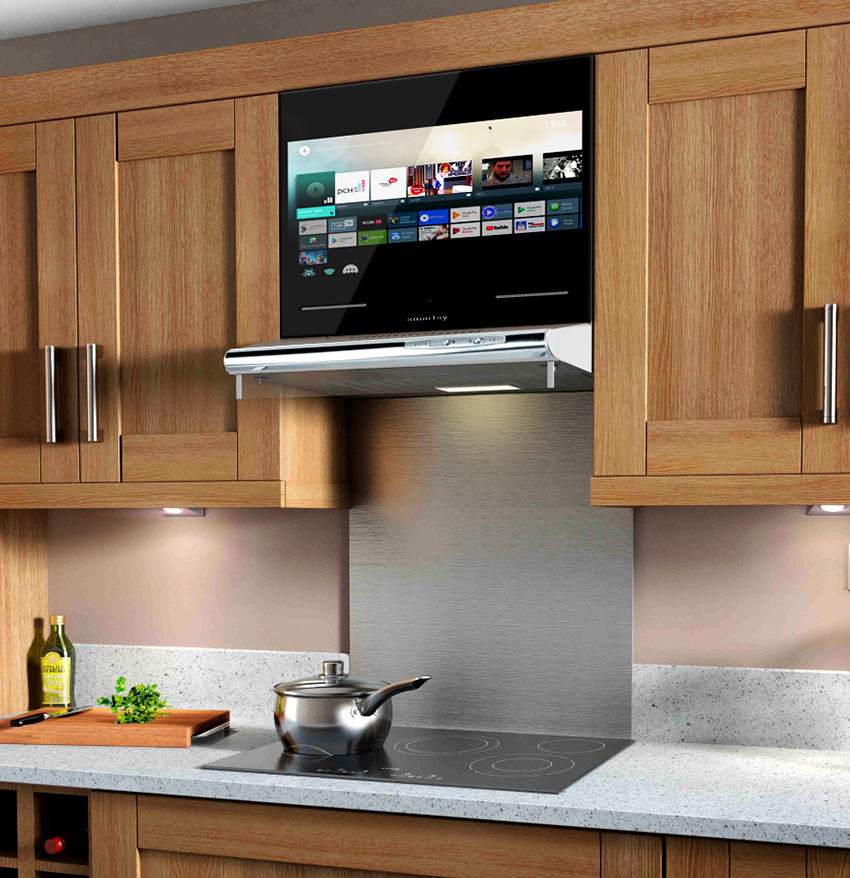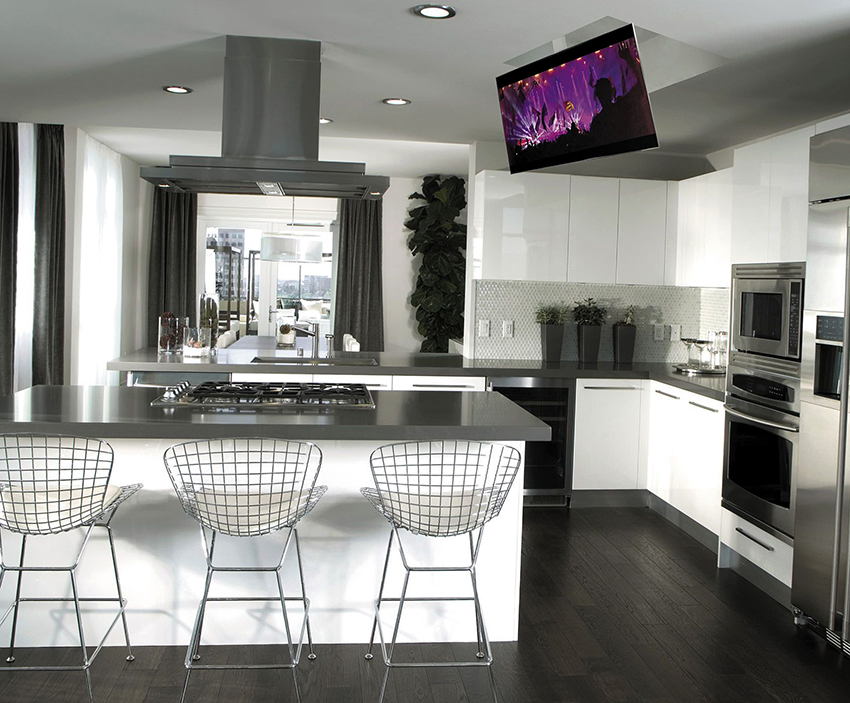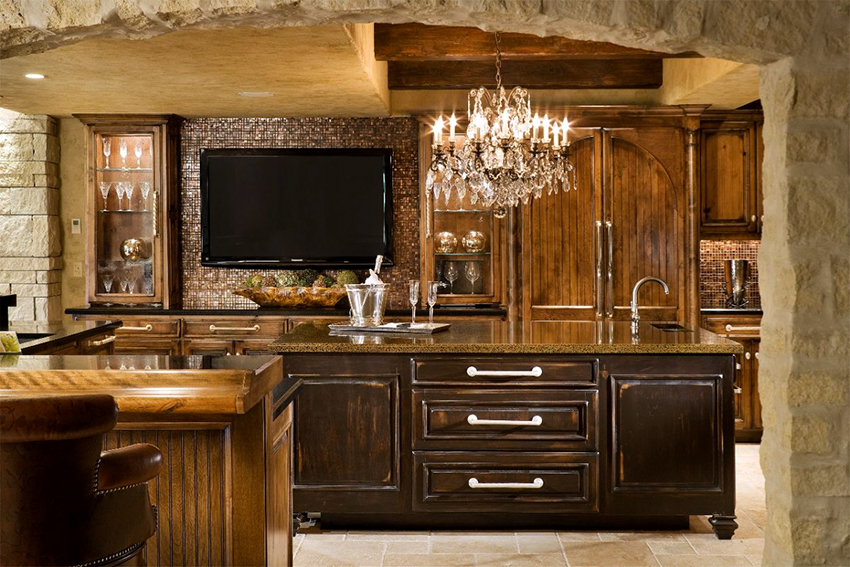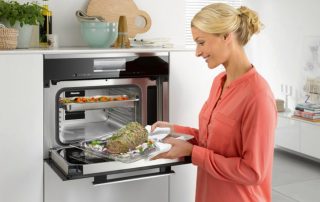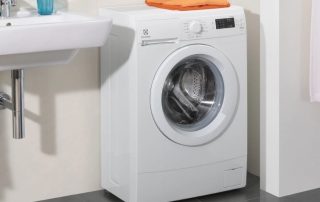Family members spend a significant amount of time in the kitchen, especially the head chef. When deciding whether to put a TV in the kitchen or not, you need to take into account the number of people living in the house and the area of the room. And if it is not recommended to use the TV during lunch, then during the cooking process you can watch the program without interrupting the cooking procedure. The main thing is to decide on the size and place of attachment.
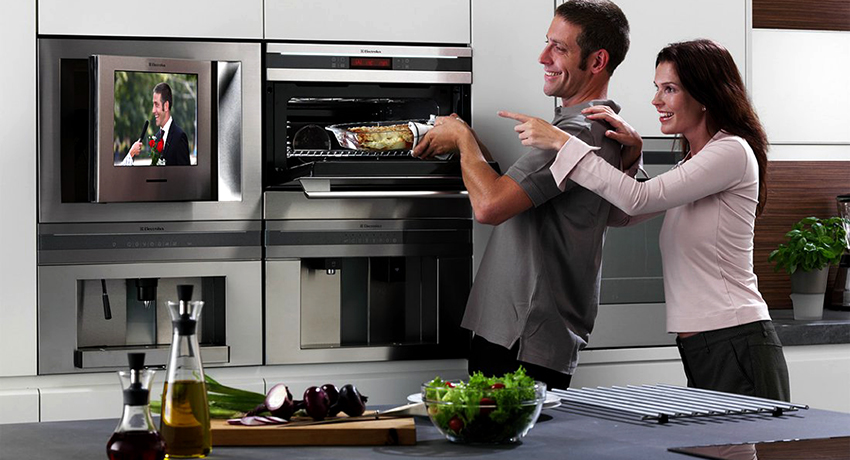
It is recommended to choose a TV in the kitchen, taking into account the frequency of visiting the room
Content [Hide]
- 1 The nuances of choosing a large and small TV in the kitchen
- 2 TV in the kitchen: how to choose the right diagonal
- 3 Technical features and additional functions of large and small TVs
- 4 The main options for placing TVs in the kitchen: photos of successful interiors
- 5 Review of medium and small TVs in the kitchen: prices and characteristics
The nuances of choosing a large and small TV in the kitchen
To choose the best TV for your kitchen, you shouldn't buy the first model you like in the mall. Before finally deciding on a purchase option, it is recommended to consider the following points:
- choose a TV in the kitchen, taking into account the frequency of visiting the room;
- do not buy a diagonal that does not correspond to the area of the room;
- give preference to a model that can be placed safely and comfortably;
- the size of the screen should not interfere with free movement around the kitchen during cooking.
Manufacturers have developed high-tech types of equipment with a built-in screen for ultra-modern interior design. This includes, for example, a cooker hood with a TV, which, in addition to the main air purification function, is distinguished by the presence of a built-in screen. However, in this case, you need to be prepared for significant spending. The same group includes modern refrigerators with integrated LCD monitors. Typically these are large Side-by-Side models with a built-in 8- or 10-inch TV, which is sufficient for background use.
Helpful advice! Before buying such an appliance, you need to understand that the kitchen is a room with high humidity and a high probability of contamination. Therefore, the TV must have a screen that is moisture and grease resistant.
TV in the kitchen: how to choose the right diagonal
Selecting the diagonal of your TV to the kitchen directly depends on the area of the room, because there are certain rules, according to which it is required to determine the optimal distance to the screen. If the kitchen is small and has an area of 6 to 9 m², you should choose a 15 "TV or no more than 17". The diagonal of this size is quite enough to comfortably watch your favorite films or programs, as well as listen to news channels. You should not try to put a large screen in a small kitchen, which takes up a lot of extra space, from which your eyes will quickly get tired and your head hurt.
In a kitchen with an average area of 10 to 15 m², there is already much more free space, so it is quite acceptable to install a screen with a larger diagonal. Both a 17 "TV and wider screens up to 25" are suitable. It is important to take into account the following requirement: the larger the diagonal, the further from the eyes the panel should be located. The optimum distance to the screen is 2 m.
A large plasma can be installed in a kitchen over 18 m², which must be properly fixed. In this case, a plasma screen with a diagonal of 25-32 ″ is considered a good option for a TV in the kitchen, because a TV of 16 inches or less in such an area will simply be lost. The basic rule is that widescreen screens must be installed at a distance of at least 2.5 m from eye level. If the kitchen has a small TV (up to 17 ″), then this distance can be reduced to 1.5 m.
When it comes to a spacious kitchen or a room combined with a living room or dining room, or it is a spacious studio apartment, then you can not limit yourself in the size of the diagonal and install a large wall-mounted TV, the diagonal of which can reach 40 ″.
Helpful advice! To find the optimal TV diagonal for the kitchen, experts recommend multiplying the length of the room by 6. The result will be considered the optimal diagonal size, which will provide a comfortable viewing.
How to choose the height and angle of the TV: photos of good options
In addition to choosing the optimal diagonal size, you need to take into account the viewing angle, which affects the color rendering of the image, no matter from what point you look at the screen. In the kitchen, a person rarely sits at the table and just watches the programs, most often the use occurs in the process of cooking, washing dishes or while performing other work. To see the picture without any distortion, you should place the TV in the kitchen at an angle of 175 °. It is this indicator that will provide a normal view, regardless of which side you look at the screen.
As for determining the required height of the TV in the kitchen, there are no clear requirements here. In some cases, it is best to install the screen near the ceiling to protect the device from falling or getting dirty. In a small kitchen area, it is recommended to install the appliances at eye level. In this case, you can look at the screen for a long time and at the same time maintain a comfortable position without lifting your head up. In a small room, it is considered optimal to install the panel at a height of 1.1 to 1.5 m.
It is wrong to locate the TV lower than a meter. Firstly, there is a high risk of the device falling due to accidental overturning, and secondly, it will be extremely inconvenient to look at the screen.
If the room is used mostly for cooking, then the best option for placing the TV in the kitchen is considered to be installed on a ceiling bracket, which will allow the device to be placed as high and safe as possible. It is also recommended to install large plasma panels under the ceiling so as not to take up free space.
Technical features and additional functions of large and small TVs
The main task of a kitchen TV is to provide a high-quality picture even at a minimum distance from the screen. Therefore, the first thing that is advised to pay attention to when buying is the presence of a high level of contrast and resolution. Before deciding which TV to choose for the kitchen, you need to know the main types of matrices found in technology.
High resolution, due to which a high-quality image is provided, are possessed by LED screens. These TV options can be viewed from any angle without distortion. Another advantage of buying such models is considered to be energy efficiency, because they consume 40% less energy than other equipment. LED-screens are characterized by a minimum thickness, which allows you to integrate the TV into a headset or a small niche on the wall. The only drawback is the high price of TVs in the kitchen.
LСD-TVs are characterized by an optimal ratio of price and quality. The main disadvantage of using is considered to limit viewing at a certain angle. A clear and high-quality image can be seen only if you sit directly in front of the screen or stand slightly to the side. Many people solve this problem by installing a swivel bracket that is mounted on the wall. On the network you can find master classes in which detailed instructions for making a device with your own hands are shown. The main thing is to fix the screen at the correct and comfortable height.
Plasma TVs. A beautiful image is provided due to the glow of the phosphor under the influence of ultraviolet rays. These TV models do not need additional illumination, because each individual plasma cell is an independent light source. Most plasma screens are characterized by a large diagonal - from 32 ″ and more. Therefore, you can install a TV either in a large kitchen, or in a combined kitchen-living-dining room, where the area of the room is more than 18-20 m².
Do you need TVs in the kitchen with Wi-Fi and smart screens
In the kitchen, you can install both a large and a small TV, choose modern high-tech equipment or purchase a traditional model. If you look at modern interiors, you can often see folding or built-in panels. When buying, it is important to evaluate the need for additional functionality of the device and understand which ones are needed in the kitchen, so as not to spend extra money.
Despite modern technology, even LED TVs can be connected to a conventional antenna and view analogue channels, the picture quality of which leaves much to be desired. However, there is no point in purchasing expensive equipment for such an elementary viewing. Therefore, such a screen is at least recommended to be connected to a device that allows you to get an image in digital format, which guarantees a clear and high-quality picture.
Support for digital broadcasting has a significant number of advantages in contrast to "analog". To obtain a digital image, the presence of a built-in tuner with minimal capabilities is sufficient, so the DVB-T2 standard is quite enough for this. In addition, the TV can also support DVB-S2 satellite digital broadcasting standards.
Another important function that a TV should be equipped with is a USB port, which allows you to connect a USB flash drive, tablet or hard drive. So, you can view previously recorded films, TV shows, family photos or videos on the big screen, as well as listen to your favorite music tracks.
If a person likes to spend time in the kitchen not watching, but listening to TV, it will be useful to have a radio function, especially since the sound from the radio can be received even when the screen is off. This saves energy and keeps you up to date with the latest news.
Nowadays, TVs in the kitchen with Wi-Fi are becoming more and more popular. The built-in module allows hosts to go online and watch movies directly from the sites. The function is especially relevant in the absence of normal cable TV. It is also very convenient, without interrupting the process, to find an interesting recipe using a smart TV in the kitchen and cook something new.
Helpful advice! Before you hang the TV on the kitchen wall, you need to carefully study the location of the connectors, which are mainly located on the side or on the back of the screen. This must be considered prior to installation in order to determine the optimum distance between the cabinet and the wall. Most experts are inclined to believe that it is the lateral location of the main exits that is considered the most convenient.
The main options for placing TVs in the kitchen: photos of successful interiors
When installing a TV in a kitchen, the first thing to consider is the amount of natural light. When the kitchen faces the south or west side, intensely illuminated by daylight, the appliances should be placed in the most shaded part of the room, closer to the entrance. Otherwise, glare will be constantly present on the screen, and the device will also heat up under the influence of sunlight, which will cause constant overheating, which may cause the equipment to fail.
For obvious reasons, you should also not mount the TV near heating devices, which include not only the hob, but also heating radiators, fireplaces, ovens and heaters.
Important! The main requirement is to fix the device away from the sink and the hob to prevent the constant ingress of moisture, splashes of dirt or grease, which will affect not only the appearance of the device, but also the life of the device.
You can install the kitchen TV on the wall or put the appliance on a shelf. The installation option depends not only on the type and size of the screen, but also on the area of the room. When buying, keep in mind that not all models are designed for shelf installation. Some versions of the devices have only a wall mounting, which is carried out with a few bolts directly to the wall surface or by using a functional bracket.
Related article:
How to hang a TV on the wall: tips for proper installation
Choice of location, height and location. Which bracket to give preference to. Advantages of wall mounting. Features of installation.
If you look at photos of TVs in the kitchen, you can often find unusual built-in layout options when the panel is placed behind a kitchen glass backsplash. This needs to be thought out even at the stage of repairing the premises in order to prepare the necessary connectors and power supplies. This installation method allows you to protect the TV from splashes and grease, because the screen is protected by a thick heat and shock-resistant glass partition. The built-in version of the equipment is also attached using a special kitchen rack, which is often used to install not only a TV, but also a microwave oven or other small household appliances.
The most popular models include a TV built into the kitchen facade. In this case, the device is installed behind the cabinet.The most progressive option is the integration of the device into special retractable mounts, which are triggered when using a button on the control panel. After pressing, the TV moves out from the top of the kitchen cabinets or any other convenient place. The popular models with such an arrangement include the following TVs:
- Avis AVS220K in black frame;
- white TV for kitchen AVIS AVS220K with optimal diagonal of 21 ″;
- LCD TV Samsung UE22H5600AKX.
Other popular options for installing a large or small TV for the kitchen
Installing the TV in a pre-designed niche is considered a good placement option because the screen is protected from accidental tipping and has a limited safety space. You can not only build the appliances into a niche, but also use part of the kitchen set for this purpose. The device is placed opposite the dining group or sitting area with upholstered furniture, and usually the upper cabinets of the kitchen set are used for this.
Helpful advice! If you resort to a rigid installation, then you can use the TV only with the cabinet doors open, which is inconvenient from the point of view of moving around the kitchen. In this case, sliding (to the sides) doors or a sash that rises upward, which, when open, cannot cause blows or injury, is more suitable.
It is considered more practical to install the TV in a pre-formed niche in the wall, made with drywall sheets. In this case, the size of the niche should be made slightly larger than the TV screen. It is important to remember: to avoid overheating the device, there must be enough space on the sides of it for free air circulation. Otherwise, if there is insufficient air supply, the panel will constantly overheat, which will significantly reduce the time of high-quality operation of the device.
The most traditional way is to install the TV on a shelf. This option is especially preferable for a small kitchen, when the TV has a small diagonal. In this case, it is permissible to put the equipment on a specially designated shelf near the kitchen or dining group. Moreover, you can easily move the screen to another location depending on your convenience.
In this situation, it is not necessary to specially attach the shelf. For this purpose, you can use any wall cabinet. The main thing is that its dimensions correspond to the parameters of the TV and allow, if necessary, to deploy the device. The place for the TV should be thought out in advance, and it is also worth asking the craftsmen to make furniture of suitable sizes.
Corner and concealed installation, fixing with bracket
If we are talking about installing a small TV in the kitchen, the option of an angular arrangement is considered convenient. To do this, using a special swivel bracket, the device is mounted in the corner of kitchen cabinets or above the soft corner in the dining area. Experts advise to choose TVs with LED displays for angular placement, which can be viewed from any angle from different points of the kitchen without interference.
When there is no other way but to install the TV near a sink or hob, it is recommended to give preference to models that differ in the presence of a protected case. In accordance with international standards, the best screen is considered to be IP65, which prevents the penetration of dust or water under the body of the device. Models with such screens can be installed even in a bathroom, because they are absolutely moisture resistant. Despite this, it is still not worth fixing such a device directly above the hob.
The swivel bracket allows you to rotate the TV after installation and fix it in the most comfortable position. It is important to choose a bracket made of quality materials that can withstand the load of the screen. In shopping malls, there are also universal models of devices suitable for screens of all sizes. The price of such a device is higher than the cost of other models, but it allows, if necessary, to replace a small screen with a large one, without having to change and rearrange the bracket. There are the following main types of fasteners:
- Ceiling. Convenient devices with which you can tilt and rotate the panel 360 °.
- Inclined. They only allow you to change the angle of the TV.
- Swivel and tilt. Allows you to rotate the screen or tilt it 180 °.
A separate group can be distinguished by modern smart brackets on the control panel, with which you can make the position of the TV comfortable without touching the screen with dirty hands.
Since you should not focus on the TV in the kitchen, you can choose a hidden method to install it and hide the device behind swivel or sliding panels, on which the equipment is fixed. In this case, the TV is reliably protected when it is not in use, and the device does not occupy a useful area.
Interesting information! In ultramodern interiors, a kitchen table or cabinet will look spectacular, on a retractable tabletop of which a small screen will be fixed, or folding TVs that leave a hidden space after pressing a button on the remote control.
Review of medium and small TVs in the kitchen: prices and characteristics
Before choosing a TV for the kitchen, you need to decide exactly on the size and functional set of characteristics. Considering user feedback, there are several models that are convenient for use in the kitchen.
Samsung UE19H400. Japanese TVs feature good build quality, small screens (up to 24 ″) and attractive modern design. With a resolution of 1366 × 768 and LED backlighting, the image is bright and high quality. The viewing angle of 178 ° allows viewing the TV from any point. Price - from 17 thousand rubles.
AVIS AVS220K. It has a diagonal of 21 ″ and is produced in two cases - white and black. It is characterized by high resolution (1920 × 1080) and good picture quality. TVs of this company are designed specifically for the kitchen and have a moisture and dustproof IP65 coating. The model features a built-in media player. The price ranges from 52.5 to 56.2 thousand rubles.
Philips 24PHT4031. The TV belongs to budget models, has a diagonal of 24 ″ and an LCD screen. It features an ultra-thin body, sharp image and beautiful design. Good reception of both analogue and digital channels is ensured by tuner supporting DVB-T / T2, DVB-C. The price of the device is from 14 thousand rubles.
Equipping the kitchen with a TV is not such a difficult task, especially if you think over the location of the device at the stage of repairing the room. When installing the device, you should take into account that it should not interfere with moving around the kitchen during cooking and take up too much space. Moreover, different placement options allow you to make the TV an accent detail of the interior or to successfully hide the device when not in use.
